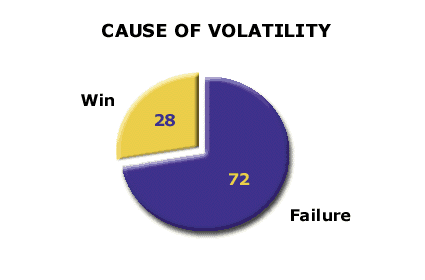BASIC STRATEGY GUIDE: STEP 7
Activity One (Steps 1-12):
Segment customers, both by size and by need, to identify targets for the Company.
Step 7: Determine whether “Wins” or “Failures” account for the majority of the industry’s positive volatility.

What:
Divide the Positive volatility of the industry into “Wins” and “Failures.”
-
A “Win” occurs when a competitor does something less than half the other competitors could do.
-
A “Failure” occurs when a competitor cannot, or will not do, something that half or more of the competitors in the market place can or will do.
A positive volatility event occurs either because a competitor “Wins” by doing something others cannot do, or gains share after another competitor, who was an incumbent in the relationship, has a “Failure” with his customer relationship. The latter event is a “weak win” for the competitor.
As part of this analysis, the Company should project the likely volume it might gain from weak compared to strong competitors. Weak competitors are market share losers while strong competitors gain market share.
Why:
The Company must adjust its strategy according to the forces moving market share in the industry. If industry volatility is primarily driven by “Failure,” the Company must diligently protect its own volume and seek to exploit the “Failure” of others. On the other hand, if the industry’s positive volatility is primarily the result of “Wins,” the Company must be sure it has the ability to keep pace with strong competitors by offering the kinds of customer benefits that are creating “Wins.”
What to Watch For:
-
The more new customers enter the market, the higher the positive volatility for the industry and the higher the percentage of volatility that results from a “win.”
-
Customers who are acquainted with the market are much more likely to move because of the “failure” of an incumbent supplier than due to a “win” by another supplier.
-
Most large, established markets have their volatility dominated by “failure.” This includes most Stable, Deteriorating and Hostile markets.
-
Many Developing industries have volatility dominated by “wins” rather than “failures.”
-
The company should find that it is likely to gain three to four times more volume from weak competitors than from strong ones.
Action:
Plan the Company’s efforts to gain market share to account both for positive volatility and the causes of that volatility. If positive volatility is low, the Company must either find a way to create it or set its volume growth expectations accordingly. If the industry’s positive volatility is primarily “failure” driven, then the Company should increase its marketing and sales concentration on the customers of weak competitors.
More Information on Win vs. Failure on the Advanced Site>>
More Information on Competitor Weakness on the Advanced Site>>
For helpful context on this step:
Videos:
Perspectives:
Symptoms and Implications:
